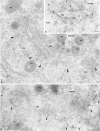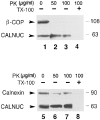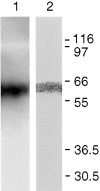The mammalian calcium-binding protein, nucleobindin (CALNUC), is a Golgi resident protein
- PMID: 9647645
- PMCID: PMC2132997
- DOI: 10.1083/jcb.141.7.1515
The mammalian calcium-binding protein, nucleobindin (CALNUC), is a Golgi resident protein
Abstract
We have identified CALNUC, an EF-hand, Ca2+-binding protein, as a Golgi resident protein. CALNUC corresponds to a previously identified EF-hand/calcium-binding protein known as nucleobindin. CALNUC interacts with Galphai3 subunits in the yeast two-hybrid system and in GST-CALNUC pull-down assays. Analysis of deletion mutants demonstrated that the EF-hand and intervening acidic regions are the site of CALNUC's interaction with Galphai3. CALNUC is found in both cytosolic and membrane fractions. The membrane pool is tightly associated with the luminal surface of Golgi membranes. CALNUC is widely expressed, as it is detected by immunofluorescence in the Golgi region of all tissues and cell lines examined. By immunoelectron microscopy, CALNUC is localized to cis-Golgi cisternae and the cis-Golgi network (CGN). CALNUC is the major Ca2+-binding protein detected by 45Ca2+-binding assay on Golgi fractions. The properties of CALNUC and its high homology to calreticulin suggest that it may play a key role in calcium homeostasis in the CGN and cis-Golgi cisternae.
Figures














Similar articles
-
Overexpression of CALNUC (nucleobindin) increases agonist and thapsigargin releasable Ca2+ storage in the Golgi.J Cell Biol. 1999 Apr 19;145(2):279-89. doi: 10.1083/jcb.145.2.279. J Cell Biol. 1999. PMID: 10209024 Free PMC article.
-
Calnuc, an EF-hand Ca(2+) binding protein, specifically interacts with the C-terminal alpha5-helix of G(alpha)i3.Proc Natl Acad Sci U S A. 2000 Jan 18;97(2):674-9. doi: 10.1073/pnas.97.2.674. Proc Natl Acad Sci U S A. 2000. PMID: 10639138 Free PMC article.
-
CALNUC (nucleobindin) is localized in the Golgi apparatus in insect cells.Eur J Cell Biol. 2000 Mar;79(3):208-17. doi: 10.1078/s0171-9335(04)70024-2. Eur J Cell Biol. 2000. PMID: 10777113
-
Calnuc: Emerging roles in calcium signaling and human diseases.IUBMB Life. 2010 Jun;62(6):436-46. doi: 10.1002/iub.341. IUBMB Life. 2010. PMID: 20503436 Review.
-
Molecular and cellular physiology of intracellular calcium stores.Physiol Rev. 1994 Jul;74(3):595-636. doi: 10.1152/physrev.1994.74.3.595. Physiol Rev. 1994. PMID: 8036248 Review. No abstract available.
Cited by
-
Genetic interactions due to constitutive and inducible gene regulation mediated by the unfolded protein response in C. elegans.PLoS Genet. 2005 Sep;1(3):e37. doi: 10.1371/journal.pgen.0010037. PLoS Genet. 2005. PMID: 16184190 Free PMC article.
-
Characterization of stanniocalcin 2, a novel target of the mammalian unfolded protein response with cytoprotective properties.Mol Cell Biol. 2004 Nov;24(21):9456-69. doi: 10.1128/MCB.24.21.9456-9469.2004. Mol Cell Biol. 2004. PMID: 15485913 Free PMC article.
-
Loss of Nucleobindin-2 Causes Insulin Resistance in Obesity without Impacting Satiety or Adiposity.Cell Rep. 2018 Jul 31;24(5):1085-1092.e6. doi: 10.1016/j.celrep.2018.06.112. Cell Rep. 2018. PMID: 30067966 Free PMC article.
-
Proteomic analysis of mineralising osteoblasts identifies novel genes related to bone matrix mineralisation.Int Orthop. 2011 Mar;35(3):447-51. doi: 10.1007/s00264-010-1076-7. Epub 2010 Jun 18. Int Orthop. 2011. PMID: 20556378 Free PMC article.
-
Activator of G protein signaling 3 is a guanine dissociation inhibitor for Galpha i subunits.Proc Natl Acad Sci U S A. 2000 Dec 19;97(26):14364-9. doi: 10.1073/pnas.97.26.14364. Proc Natl Acad Sci U S A. 2000. PMID: 11121039 Free PMC article.
References
-
- Baksh, S., and M. Michalak. 1996. Basic characteristics and ion binding to calreticulin. In Calreticulin. M. Michalak, editor. R.G. Landes Company, Georgetown. 11–26.
-
- Booth C, Koch GLE. Perturbation of cellular calcium induces secretion of luminal ER proteins. Cell. 1989;59:729–737. - PubMed
-
- Bordier C. Phase separation of integral membrane proteins in Triton X-114 solution. J Biol Chem. 1991;256:1604–1607. - PubMed
Publication types
MeSH terms
Substances
Grants and funding
LinkOut - more resources
Full Text Sources
Other Literature Sources
Molecular Biology Databases
Research Materials
Miscellaneous

